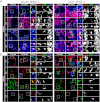Trafficking and replication patterns reveal splenic macrophages as major targets of dengue virus in mice
- PMID: 22933295
- PMCID: PMC3486461
- DOI: 10.1128/JVI.00375-12
Trafficking and replication patterns reveal splenic macrophages as major targets of dengue virus in mice
Abstract
Human postmortem studies of natural dengue virus (DENV) infection have reported systemically distributed viral antigen. Although it is widely accepted that DENV infects mononuclear phagocytes, the sequence in which specific tissues and cell types are targeted remains uncharacterized. We previously reported that mice lacking alpha/beta and gamma interferon receptors permit high levels of DENV replication and show signs of systemic disease (T. R. Prestwood et al., J. Virol. 82:8411-8421, 2008). Here we demonstrate that within 6 h, DENV traffics to and replicates in both CD169(+) and SIGN-R1(+) macrophages of the splenic marginal zone or draining lymph node, respectively, following intravenous or intrafootpad inoculation. Subsequently, high levels of replication are detected in F4/80(+) splenic red pulp macrophages and in the bone marrow, lymph nodes, and Peyer's patches. Intravenously inoculated mice begin to succumb to dengue disease 72 h after infection, at which time viral replication occurs systemically, except in lymphoid tissues. In particular, high levels of replication occur in CD68(+) macrophages of the kidneys, heart, thymus, and gastrointestinal tract. Over the course of infection, proportionately large quantities of DENV traffic to the liver and spleen. However, late during infection, viral trafficking to the spleen decreases, while trafficking to the liver, thymus, and kidneys increases. The present study demonstrates that macrophage populations, initially in the spleen and other lymphoid tissues and later in nonlymphoid tissues, are major targets of DENV infection in vivo.
Figures







Similar articles
-
The anatomy of peripheral lymphoid organs with emphasis on accessory cells: light-microscopic immunocytochemical studies of mouse spleen, lymph node, and Peyer's patch.Am J Anat. 1984 Jul;170(3):465-81. doi: 10.1002/aja.1001700318. Am J Anat. 1984. PMID: 6475812
-
Dengue virus infects macrophages and dendritic cells in a mouse model of infection.J Infect Dis. 2007 Jun 15;195(12):1808-17. doi: 10.1086/518007. Epub 2007 May 9. J Infect Dis. 2007. PMID: 17492597
-
Depletion of macrophages in mice results in higher dengue virus titers and highlights the role of macrophages for virus control.Eur J Immunol. 2009 Oct;39(10):2809-21. doi: 10.1002/eji.200939389. Eur J Immunol. 2009. PMID: 19637226
-
Nucleocytoplasmic Trafficking of Dengue Non-structural Protein 5 as a Target for Antivirals.Adv Exp Med Biol. 2018;1062:199-213. doi: 10.1007/978-981-10-8727-1_15. Adv Exp Med Biol. 2018. PMID: 29845535 Review.
-
Role of angiotensin II in cellular entry and replication of dengue virus.Arch Virol. 2024 May 16;169(6):121. doi: 10.1007/s00705-024-06040-4. Arch Virol. 2024. PMID: 38753119 Review.
Cited by
-
Immune Response to Dengue and Zika.Annu Rev Immunol. 2018 Apr 26;36:279-308. doi: 10.1146/annurev-immunol-042617-053142. Epub 2018 Jan 18. Annu Rev Immunol. 2018. PMID: 29345964 Free PMC article. Review.
-
SREBP2-dependent lipid gene transcription enhances the infection of human dendritic cells by Zika virus.Nat Commun. 2022 Sep 12;13(1):5341. doi: 10.1038/s41467-022-33041-1. Nat Commun. 2022. PMID: 36097162 Free PMC article.
-
Immune outcomes of Zika virus infection in nonhuman primates.Sci Rep. 2020 Aug 3;10(1):13069. doi: 10.1038/s41598-020-69978-w. Sci Rep. 2020. PMID: 32747639 Free PMC article.
-
Transcriptional Profiling Confirms the Therapeutic Effects of Mast Cell Stabilization in a Dengue Disease Model.J Virol. 2017 Aug 24;91(18):e00617-17. doi: 10.1128/JVI.00617-17. Print 2017 Sep 15. J Virol. 2017. PMID: 28659489 Free PMC article.
-
Insight into the Tropism of Dengue Virus in Humans.Viruses. 2019 Dec 9;11(12):1136. doi: 10.3390/v11121136. Viruses. 2019. PMID: 31835302 Free PMC article. Review.
References
-
- Balsitis SJ, et al. 2009. Tropism of dengue virus in mice and humans defined by viral nonstructural protein 3-specific immunostaining. Am. J. Trop. Med. Hyg. 80:416–424 - PubMed
-
- Balsitis SJ, et al. 2010. Lethal antibody enhancement of dengue disease in mice is prevented by Fc modification. PLoS Pathog. 6:e1000790 doi:10.1371/journal.ppat.1000790 - DOI - PMC - PubMed
-
- Bhoopat L, et al. 1996. Immunohistochemical characterization of a new monoclonal antibody reactive with dengue virus-infected cells in frozen tissue using immunoperoxidase technique. Asian Pac. J. Allergy Immunol. 14:107–113 - PubMed
Publication types
MeSH terms
Substances
Grants and funding
LinkOut - more resources
Full Text Sources
Other Literature Sources
Medical
Molecular Biology Databases

